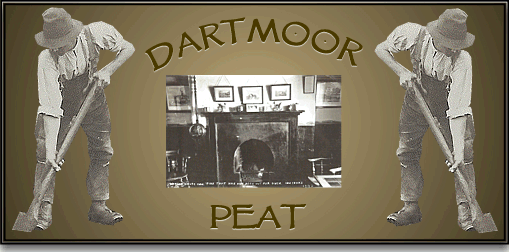
Dartmoor Peat is not a person although some letterboxers may dispute that fact, obviously we are talking about the very substance of the moor. Throughout the centuries this valuable commodity has fuelled the early industries, warmed the moorfolk’s cotts, cooked their food and has also been used to make by-products such as naphtha. Basically peat took the place of wood on Dartmoor and in the 18th century people who cut and sold it were known as ‘colliers’.
The Dartmoor peat was formed from decomposing vegetable matter which over time build up layer upon layer, this forms the ‘blanket bog’ of which there is around 120 square kilometres on Dartmoor. As this happened the layers became compressed thus forming the solid peat. There are two divisions of peat, thick which occurs at depths varying from 30cm to several metres and is called the ‘Catoelm’ and thin which occurs normally no more than 30cm deep and is known as the ‘Acrotelm’. The Acrotelm consists of sphagnum moss, the majority of which is still alive. The Catoelm is made up of dead, compressed sphagnum moss fragments and is waterlogged. The picture below was taken on the edge of Omen Beam where the peat layer thins out and it is interesting to compare this with the peat depth in the picture taken at Cranmere Pool.
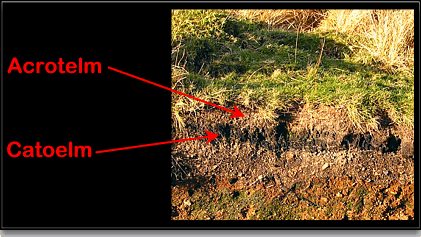
Peat will only form where slope angles are less than 15° and on Northern Dartmoor at altitudes of between 1,800 and 1,500 ft. On Southern Dartmoor it forms at heights of between 1,500 and 1,200ft. There are very few areas on the moor where the peat is still accumulating and these tend to be around the wettest places such as Taw Head and East Dart Head, elsewhere the peat is being shrunk by natural erosion. It has been noted that in some places of the moor the peat was 20ft deep although this is disputable, however I have stood in peat gullies which have been over my head which means it was at least 6ft 2 deep. Compared to other peat lands the Dartmoor peat is considered as acidic which when viewed from an archaeological perspective is highly destructive.

Peat Formation at Cranmere Pool.
Dartmoor is littered with the remains and relics of man’s exploitation of this natural resource from the turf ties to the peat cutter’s huts. There are various moorland terms for peat such as ‘turves’ or ‘black wood’. Many place-names on the moor that have derived from or are associated with peat. On Dartmoor, some place-names with a descriptive ‘black‘ element relates to peat. Therefore there is the ‘Blackwood Lane’ and ‘Black Lane’, both are old tracks used by the peat-cutters to get to the turf ties. Then to name but a few, there is Black Beam, Black Down, Black Fen, Black Hill, Black Hole, Black Hut, Black Moor, Black Ridge, Blackabrook, Coalmoor Head, Turf Hill, Turf House, Turf Road, Turver and Stooky Moor (which refers to the stacks or ‘stooks’ of peat). Probably one of the earliest recorded place-name is the ‘Turbary of Alberysheved‘ which is noted in the 1240 perambulation of the Forest bounds and today is known as Turf Hill. The right of Turbary was granted to the commoners of Dartmoor centuries ago and it allowed them to cut peat for fuel.
The earliest industrial use of peat was by the early tinners of the 12th century and its cutting was granted as a privilege in a charter of King John in 1201. In a writ of 1219 King Henry III decreed that as far as peat was concerned men should be allowed “to dig, burn and lead away from the Turbary of Dartmoor for use in the stannaries.” In 1222 the king further demanded that nobody should hinder the tinners of Devon from taking peat. The peat was turned into charcoal by means of carbonisation and it is estimated that peat charcoal has the same calorific value as good coal with 100lb of dried peat yielding roughly 36lb of charcoal. This meant that in the tin smelting process peat charcoal was purer than coal and was much lighter to carry. The first documentary evidence is for charcoal making dates to 1297 when it is known that 27 Carbonarii or charcoal burners each paid 5d for the right to make charcoal. In 1347 the list of licensed Carbonarii included a woman called Margaret Mirifeld which seems to be the only female on the list. In 1466 the tinners from Cornwall were granted permission to come to Dartmoor and cut peat as their own natural supplies had run out. Over the years the annual list of licensed charcoal burners ranged from 7 to 100. Evidence for the peat charcoal process can be seen on Wild Tor in the shape of ‘meilers’ and kilns which were used to pile the peat around and then carbonise it into charcoal. Today the meilers resemble prehistoric barrows and the kilns could easily be mistaken for a cairn
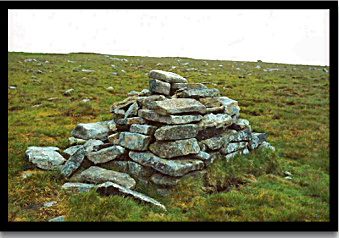
Wild Tor kiln.
Such was the quality of the Dartmoor peat charcoal that men travelled from the Cornish tine mines with packhorse trains to collect it. The one draw-back to peat charcoal is that it is capable of holding a lot of water in proportion to its solid mass and it is capable of taking up moisture quicker than it can lose it. This means there is a considerable amount of drying needed before it can be used. Once coal became more easily available it soon replaced peat charcoal in the tin smelters purely due to production costs.
It has been suggested that industrial peat cutting and charcoal activities lasted from the 1200’s to the early 1800’s and were responsible for stripping large areas of Dartmoor, in some cases down to the bed rock. During the 19th century the peat in some parts of the moor was extracted on a commercial basis. In general most of these concerns originally had hopes of good returns but many were short lived. In January 1827 the following report appeared in The Times:
“A paragraph has recently appeared in other papers stating that the peat of Dartmoor had been tried at Sheffield and other places as a substitute for coal in the production of gas, and that the experiment had succeeded beyond all expectation. We understand, however, that this is not the fact; but that experiments have been made in this vicinity, and that, though the peat is found to contain gas, yet that it does not contain such a quantity as would warrant its general use, or render it a profitable substitute for coal. Some hopes, however, are held out that this peat may be advantageously employed in the smelting of iron, with which mineral it is known that Dartmoor abounds. We give this last rumour as we have heard it, without vouching for its accuracy, because we entertain a very different opinion as to the smelting powers of peat – Western Luminary.“
There was a peat works at Walkham Head which supplied large quantities of peat for use in the mines around Mary Tavy, these included Wheal Betsy and Wheal Friendship. The peat would be cut and dried and then transported down Black Lane the 5 miles to Mary Tavy. Today many of the turf ties can be seen along with the remains of a store house now called the ‘Turf House’, which could easily be mistaken for a standing stone. Originally there were eight granite pillars that formed the house where the peat turves would be stacked to. Another such place was the Rattlebrook Peat Works which were located near Great Links Tor. Here the peat was extracted from Amicombe Hill and transported down to Bridestowe station via a combination of horse drawn trucks and a railway. The venture began in 1879 and immediately failed due to the cost of maintaining the railway. Further attempts were made to revive the enterprise in the early 1900’s but these too failed and the works was finally closed in 1955.
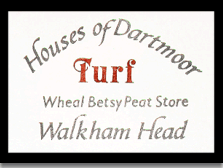
Letterbox Stamp from the Turf House
Another area of commercial peat extraction was in the Greena Ball/Holming Beam/Fice’s Well area which is located above Princetown. Peat has an average content of 65% volatile matter and when distilled it is possible to obtain naphtha, so with this in mind Peter Adams and Jacob Hall started the British Patent Naphtha Company in 1844. It was initially based at Bachelor’s Hall but in 1846 moved to the empty Princetown Prison. The peat was brought down from the ties in horse drawn wagons on a tramway, parts of which can still be seen today. This was then distilled to extract the naphtha oils which were used to produce candles, mothballs and gas for lighting. The fibrous top peat was also used to make paper, this process alone consumed 30 tons of peat a day. Once again this venture lasted but a few years and the factory reverted back to a prison where in the 1870’s peat dug by the inmates was used to make gas which lit the prison.
There was another naphtha works at Shipley Bridge, here the peat was taken from the Redlake area and transported to the works via the Zeal Tor tramway in horse drawn trucks. This venture lasted from 1846 to 1850 when the owners, Messrs Davy and Wilkin dissolved the partnership.
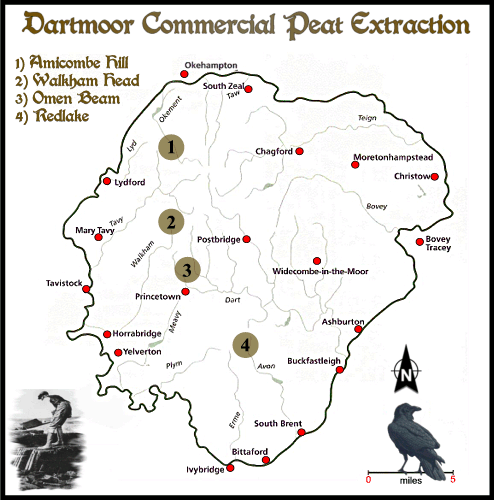
Map showing the main areas of commercial peat extraction.
Other peat cutting relics are the small peat cutters huts that today are but low walls. There are two of these to be found on Whitehorse Hill, of which one is called Moute’s Inn. Another one is located on Winney’s Down and is known as Statt’s house and this measures a meagre 12½ x 6½ ft. It was thought that these shelters date from around the 17th century which would place them at the hey-day of turf cutting. During the cutting season the men would live in these tiny and cramped huts, returning only when prolonged spells of bad weather prevented work or they had cut sufficient for their needs
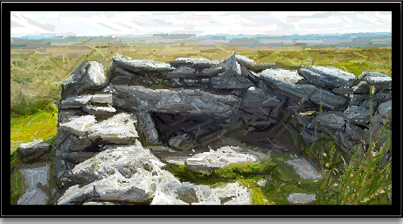
Statt’s House
As with many landscapes it is amazing to see how man can deface his natural surroundings when in search of a resource or profit. The Rattlebrook area is one such example, from the ground it is possible to see the outlines of the turf ties as they tend to be slightly lower than the surrounding ground. But from the air the true extent of landscape scarring is another matter. The aerial photograph below clearly shows the area of industrial peat extraction and the really sad thing is that the venture was short lived and in the end unviable.
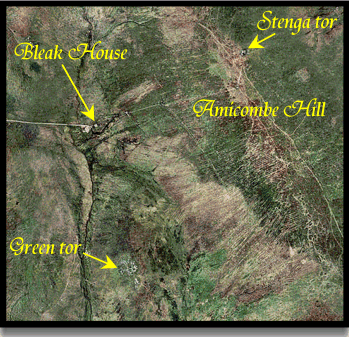
Part of the Rattlebrook Peat Works
Apart from the ‘black stick‘ (gorse) and the odd log or two, wood was pretty scarce on Dartmoor and so peat was the moorman’s only source of fuel. It was customary for every farm and small-holding to have their own turf-tie where they would cut peat. There was an unwritten rule that nobody interfered with anybody else’s ‘tie’. Sabine Baring Gould remarks on a Dartmoor peat fire and notes:
“And then the peat fires! What fires can surpass them? They do not flame, but they glow, and diffuse an aroma that fills the lungs with balm… I may be mistaken, but it seems to me that cooking done over a peat fire surpasses cooking at the best club in London. But it may be that on the moor one relishes a meal in a manner impossible elsewhere.“
In some areas the peat was called ‘pluffy’ or ‘hard’, the pluffy peat was good for heating and the hard peat was excellent for heating ovens.
Peat cutting would take place between April and early September depending on other priorities and weather, although on farms it was usually done before the hay harvest. It was usual to cut the peat in long strips called ‘journeys’ which were roughly 40 yards in length. The process of peat cutting entailed firstly trimming off the edge of the cut with a ‘slitting knife’ which was between 2.5ft and 3ft long and about 4″ wide. Then with the same tool, an initial deep cut was made into the peat 14″ from the edge. The top layer of soil and vegetation would then be removed by the cutter standing in the tie and slicing horizontally into the peat face. This would be done by using a Devon spade for shallow depths or a ‘budding iron’, sometimes known as a ‘spending ire’, for deeper depths, this was a type of shovel but it had a triangular, flatter head with a straight handle. The spoil would be thrown into the tie and saved for back-filling at a later date. Once the peat face was cleaned the cutter would be left with a small ledge along which he would walk backwards cutting the turves. For this a ‘turf iron’ or in the vernacular – a ‘turf ire’, was used, this was a piece of 7″ wide, flattened iron with a sharp, slightly rounded end. Along on side there was a pointed triangular ‘side panel’ which was bent upwards at right-angles. The top end of the iron had a handle socket and a 90° shoulder for placing the foot.
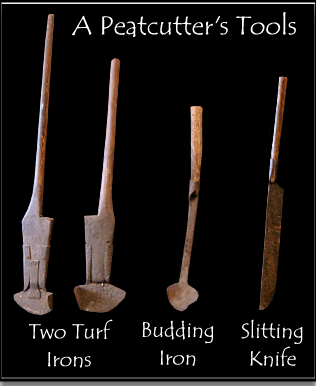
Many thanks to the Dartmoor National Park
High Moor visitors centre for allowing the
tools to be photographed.
The cutter would slice the turf-iron into the peat about 2″ from the end, then he would make a series of short downwards vertical cuts down to a depth of 20″. The 90° ‘side panel’ would help in removing the square edged section. When the desired depth was reached a horizontal cut was made to remove the turve which would measure 20″ x 7″ x 2″. A double row would be cut in this manner all along the 14″ ledge of peat, a competent cutter would normally consider to complete two journeys in a day. It was estimated that one journey would yield 1,440 slabs of peat.
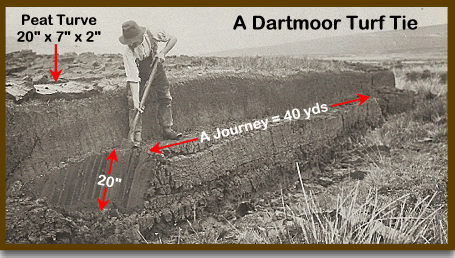
The cut peat would then either be stood in pairs or laid along the tie to dry, after 2 – 3 weeks the dry turves would then be stacked in stooks. Once the peat had dried sufficiently it was then taken off the moor and stacked in thatched ricks. The early peat cutters would use ponies to transport the peat down from the moor, later reverting to pony carts and sleds. It was estimated that the average farm would have needed 40 cartloads of peat to last throughout the coming year which meant one peat tie would last a farm for about 20 years.
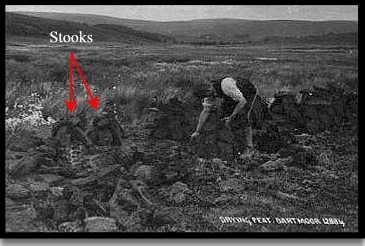
An early postcard showing a cutter drying his peat.
Once the cutter’s own peat needs had been satisfied the surplus would be taken to the moorland towns and villages and sold. Many villages would have a ‘communal’ peat stack where if the snows set in the inhabitants would have an emergency supply of peat. Lydford was such a place where the peat stack was behind the old castle. If dried properly, peat would give an excellent steady and even heat, if at night the ashes (known as ‘briss’) were put back on top of the fire it was possible to keep it alight until the following morning. There was an old saying that a “yafful o’ turve” will make a cracking fire. The advancement of the railways in the early 1900’s meant that coal became readily available to the town and village folk, this resulted in the domestic peat trade dwindling out and in the end it was just the moor folk who used it on their fires. Writing in 1797, John Swete gives an excellent account of a peat cutter whom he met on the moor:
“… He first pared of about 8 or 10 inches of an upper superficies, which consisting of mere vegetable matter, was considered as little worth, and generally thrown away – the body that now appeared, seem’d to be of a closer texture and more fat and bituminous: – the cut which He now made was 15 inches long, 6 wide and 2 thick – these were sold by the piece, and when dry, He carried 20 of them to Tavistocke (6 miles) for 2d. the third layer, or rather the second of Peat was the finest, the cut made of this, (excepting one inch of greater thickness) was of the same dimensions as the former, and for 6 score of these, at the town, He was paid 15d...”
On the edges of the moor, the peat deposits lessen until the soil turns to ordinary turf. Although nowhere near as an efficient fuel source this would be cut and dried in the same manner and the slabs of this were known as ‘Vags’. At one time a ‘vag iron’ would be used to cut the turf, this was similar in appearance to a budding iron but it had a large wing on the side, this type of iron was a lot bigger and needed two men to operate it.

Baring Gould, S. 1923 A Book of Dartmoor, Methuen, London, p.180
Crossing, W. 1966 The Dartmoor Worker, David & Charles, Newton Abbot, pp 48 – 53.
Gill, G. (Ed) 1977 Dartmoor – A New Study, David & Charles, Newton Abbot, pp 129 -30
Harris, H. 1992 The Industrial Archaeology of Dartmoor, Peninsula Press, Newton Abbot, pp 98 – 115.
Swete, J. 2000 Travels in Georgian Devon – Vol. IV, Halsgrove Pub., Tiverton. p.65.
 Legendary Dartmoor The many aspects past and present of Dartmoor
Legendary Dartmoor The many aspects past and present of Dartmoor

Hi Tim, Great information, thank you. Does peat-cutting still occur to this day on the Moors?
Not to the best of my knowledge.